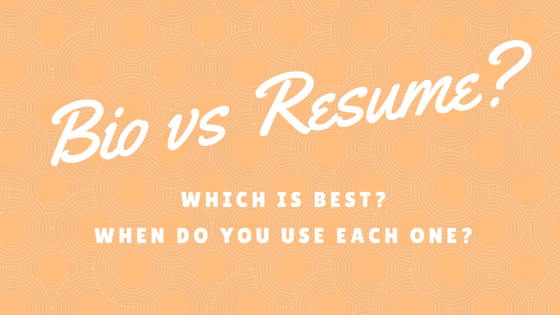 It’s amazing how quickly things change in the business and career arenas. For ages all you needed was a resume when applying for a job. Now it seems that not only do you need a resume, you also need a professional bio and maybe even a LinkedIn page.
It’s amazing how quickly things change in the business and career arenas. For ages all you needed was a resume when applying for a job. Now it seems that not only do you need a resume, you also need a professional bio and maybe even a LinkedIn page.
Holy cow! It’s getting more complicated every day.
Well, one thing that I can help you with is understanding the difference between a resume and a professional biography.
The most important distinction between bio and resume
First thing to know is that a bio tells a story about you, whereas a resume gives a summary of your complete work history. Both describe your background but the level of detail and presentation are different. Between the two, the bio is more interesting and easier to read than a resume.
Some employers want just one or the other, but most seem to ask for both a resume and a bio these days.
When to use a bio
A bio or biography tells a story about you, whereas a resume gives “just the facts.” A bio is a promotional document; a resume is used when applying for a job. Both describe your background but purpose, level of detail and presentation are different. Between the two, the bio is less formal and more interesting to read than the resume.
Use a bio to tell a narrative story about you. This may be for a company website, a blurb at the bottom of an article, or any other use where you need a concise but interesting snapshot of you and your achievements.
Your bio is intended to be a concise, compelling overview of the person. In a paragraph or two, the most impressive facts are provided to give a picture to the reader. The description normally is written in the third person and may include years of experience, some well-known companies, recognized commercial awards, marital status, number of children, and other details.
Frankly, a career biography is basically promotional material: it tells a short story about you in a couple of paragraphs. It’s a summarized version of who you are, what you’re all about, and why the reader should listen to you.
Another way to think about it is that a professional bio is a little advertisement for you – and by extension – for your company as well. It summarizes just the most impressive highlights of your background. In contrast, a resume gives a complete summary of your experience, education, and skills – normally in chronological order.
To sum up, a professional biography is:
- basically used as promotional material or as an introduction blurb
- often found in the “about me” or “profile” section of a website, as well as on printed and web materials for motivational speakers, company CEOs, business owners, and book or article authors
- an overview of the person written in a narrative form (sentences and paragraphs)
- normally written in the third person
- usually includes includes years of experience, some well-known companies, and recognized industry awards
- may optionally include marital status, number of children, place of dwelling, and other personal details
- basically a short story and more interesting to read than a resume
- normally not sufficient to submit for a job application
When to use a resume
A resume is normally required when applying for a job. A resume shows past history and provides in detail, the working experience, job positions and responsibilities, education with colleges attended, skill certificates achieved and trainings completed.
Whereas a bio is usually formatted in paragraphs, resumes are normally formatted in bullet form and chronological order. You need to account for any missing years that may have occurred due to sickness, travelling, family responsibilities or time out of the workforce. In a pinch, you can omit certain areas in your resume if you wish and only reveal them in person when you have an interview.
A resume is:
- normally required when applying for a job
- a summary of past work history, education and training (provides in detail the work experience, job positions and responsibilities, education with colleges attended, skill certificates achieved and trainings completed)
- normally formatted in bullet form and chronological order
- more formal than a bio
- usually longer than a bio
Help is here!
A bio template simplifies the process of writing a professional bio If you are looking for a bio template, please visit How to Write a Bio where I provide downloadable fill-in-the-blank bio templates for over 150 different types of jobs. You’ll have it done in the correct style and format within the next 20 minutes.